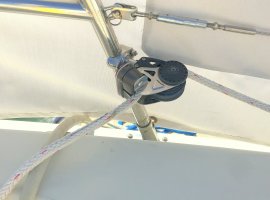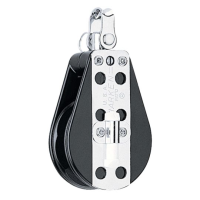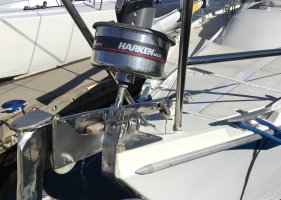First, I like this new (sub) forum; thanks to whomever thought it up!
Second:
How do you prevent jib-sheet fouling during singlehanded tacks in 30-35 kt winds?
--> This really is a high-wind question; please respond with what you know works in 28+ kts, give or take... the flogging of the sheets up there is quite different than in 25 kts or less.
I would definitely appreciate advice -- I am very comfortable singlehanding in 25kts and less (common on SF Bay). However, yesterday I went out in 28 sustained where I was, gusting to 30-35. (I know... why? Because, aside from the fact that it was a beautiful day, as one of @Christian's youtube videos says, 'practice') Said practice was very useful in revealing deficiencies of gear and training; many things (e.g. time for newer foulies) I can figure out for myself, but one I would like advice on: jib sheet fouling.
Details (if you want to read this much):
Given the high winds, I initially tried to roll out only 2/3 of my jib, while motoring upwind enough to maintain steerage. This went badly -- first, I needed to unroll the jib fully so I could tighten the halyard (on the advice of my sailmaker, I ease it before furling to reduce sail stretching), then I needed to partially re-furl.
But by then the flogging sheets, which often tangle a little bit, were a hopeless massive (literally) knot. Worse, it was frankly dangerous on the foredeck due to the flogging sheets (hence 'flogging'...) plus heavy knot -- well beyond my usual tactic of standing back and flicking a few wraps over one sheet. The only thing I could figure out to do was to go back to the cockpit and fully re-furl the jib, then go forward again to sort it out.
Then, kneeling on the foredeck with lots of water over me all the time (c.f.: need for new foulies), I confronted the knot -- large, with two ends to the jib clew, two to the sheet fairleads.. which is to say, highly confusing. Worse, it was tight. Very tight... luckily I had my marlin spike on me, but even with that it was 10-15 minutes to get the sheets sorted. I then fell off to a broad reach and unfurled only then, when one sheet would be mostly under load during the whole process and thus less likely to flog/foul.
That procedure worked... but nothing about all this was reassuring -- if conditions had been bad, I am not sure what I would have done. Wouldn't have taken too much wave height (or a lee shore) to make my solution of turning onto a different heading potentially undesirable. And I do not want to find myself having to be on the foredeck for long periods in bad conditions. So:
--> How do you normally handle this (singlehanded)?
a. during initial unfurling (or maybe sail changes?)
b. (especially) during tacks in high (25+ kt) winds?
Re: (b), tacks, in 25kts: I usually put multiple winch turns on the lazy sheet and pull it in tight before the tack, to reduce the problem... but, especially with higher winds, easing the working sheet during the tack is hard whilst also steering through the tack with one hand to keep the tack slow enough that I can pull in the new working sheet -- I prefer to get head to wind quickly, then go very slow from there, to give me time to just pull, rather than later difficultly grind, in the new working sheet. So I usually pull the wraps off the leeward winch with one hand just as the jib starts to luff, then shift hands on the wheel and use the other hand to pull in the new working sheet as I get through the wind. But that involves enough slack in the sheets -- especially the formerly-working sheet which I am completely releasing* -- that I have often gotten minor tangles. It is those appear able to go from a minor annoyance to a serious problem with higher wind.
I'm pretty sure there is a known way of dealing with this, but I am not aware of it. Rather than try to invent one, I though I would solicit your advice.
Many thanks for any tips!
PS:
* Well, one turn on the winch to provide friction to keep it near me, but that is not enough to control it, or even hold it in that kind of wind, and 2-3 wraps leads in my experience to overrides that are also highly concerning.
PPS: I had less tangling issues with my old sheets, which were 5/8" (came with the boat when I bought it). My new ones are 1/2" ("sta-set") -- spec for the boat, so why use bigger? -- but those foul more (due to worse flogging) and also slip more easily on the winch barrel and stick poorly in the self-tailers (I had the boatyard look at those; they could not find anything wrong with the springs/etc in the self-tailers). Maybe I need to go back to 5/8" sheets?
PPPS: You could tell the unusually high wind was a general problem -- CH 16 revealed a very busy USCG all day.
Second:
How do you prevent jib-sheet fouling during singlehanded tacks in 30-35 kt winds?
--> This really is a high-wind question; please respond with what you know works in 28+ kts, give or take... the flogging of the sheets up there is quite different than in 25 kts or less.
I would definitely appreciate advice -- I am very comfortable singlehanding in 25kts and less (common on SF Bay). However, yesterday I went out in 28 sustained where I was, gusting to 30-35. (I know... why? Because, aside from the fact that it was a beautiful day, as one of @Christian's youtube videos says, 'practice') Said practice was very useful in revealing deficiencies of gear and training; many things (e.g. time for newer foulies) I can figure out for myself, but one I would like advice on: jib sheet fouling.
Details (if you want to read this much):
Given the high winds, I initially tried to roll out only 2/3 of my jib, while motoring upwind enough to maintain steerage. This went badly -- first, I needed to unroll the jib fully so I could tighten the halyard (on the advice of my sailmaker, I ease it before furling to reduce sail stretching), then I needed to partially re-furl.
But by then the flogging sheets, which often tangle a little bit, were a hopeless massive (literally) knot. Worse, it was frankly dangerous on the foredeck due to the flogging sheets (hence 'flogging'...) plus heavy knot -- well beyond my usual tactic of standing back and flicking a few wraps over one sheet. The only thing I could figure out to do was to go back to the cockpit and fully re-furl the jib, then go forward again to sort it out.
Then, kneeling on the foredeck with lots of water over me all the time (c.f.: need for new foulies), I confronted the knot -- large, with two ends to the jib clew, two to the sheet fairleads.. which is to say, highly confusing. Worse, it was tight. Very tight... luckily I had my marlin spike on me, but even with that it was 10-15 minutes to get the sheets sorted. I then fell off to a broad reach and unfurled only then, when one sheet would be mostly under load during the whole process and thus less likely to flog/foul.
That procedure worked... but nothing about all this was reassuring -- if conditions had been bad, I am not sure what I would have done. Wouldn't have taken too much wave height (or a lee shore) to make my solution of turning onto a different heading potentially undesirable. And I do not want to find myself having to be on the foredeck for long periods in bad conditions. So:
--> How do you normally handle this (singlehanded)?
a. during initial unfurling (or maybe sail changes?)
b. (especially) during tacks in high (25+ kt) winds?
Re: (b), tacks, in 25kts: I usually put multiple winch turns on the lazy sheet and pull it in tight before the tack, to reduce the problem... but, especially with higher winds, easing the working sheet during the tack is hard whilst also steering through the tack with one hand to keep the tack slow enough that I can pull in the new working sheet -- I prefer to get head to wind quickly, then go very slow from there, to give me time to just pull, rather than later difficultly grind, in the new working sheet. So I usually pull the wraps off the leeward winch with one hand just as the jib starts to luff, then shift hands on the wheel and use the other hand to pull in the new working sheet as I get through the wind. But that involves enough slack in the sheets -- especially the formerly-working sheet which I am completely releasing* -- that I have often gotten minor tangles. It is those appear able to go from a minor annoyance to a serious problem with higher wind.
I'm pretty sure there is a known way of dealing with this, but I am not aware of it. Rather than try to invent one, I though I would solicit your advice.
Many thanks for any tips!
PS:
* Well, one turn on the winch to provide friction to keep it near me, but that is not enough to control it, or even hold it in that kind of wind, and 2-3 wraps leads in my experience to overrides that are also highly concerning.
PPS: I had less tangling issues with my old sheets, which were 5/8" (came with the boat when I bought it). My new ones are 1/2" ("sta-set") -- spec for the boat, so why use bigger? -- but those foul more (due to worse flogging) and also slip more easily on the winch barrel and stick poorly in the self-tailers (I had the boatyard look at those; they could not find anything wrong with the springs/etc in the self-tailers). Maybe I need to go back to 5/8" sheets?
PPPS: You could tell the unusually high wind was a general problem -- CH 16 revealed a very busy USCG all day.



